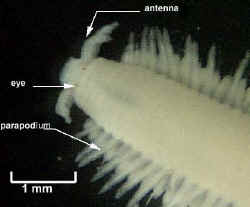 Prostomium
Prostomium
Prostomium is rounded.
2 palps and 2 antennae; have joints on antennae; presence
or absence of a nuchal papilla.
With or without eyes. Different species vary with 1 or 2
pairs of eyes.
Mandibles usually dentate. Maxillae consist of 2 or 4 rows
of numerous minute toothed plates.


Prostomium
